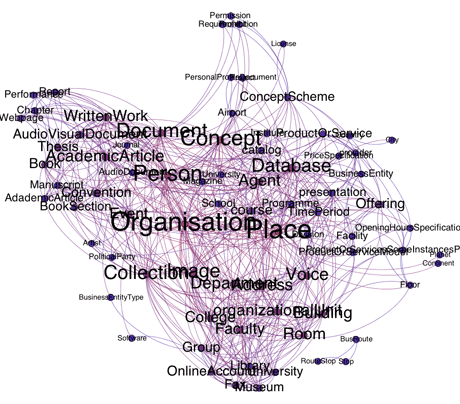by Mathieu d'Aquin and Stefan Dietze
Education is now entering a revolution in the form of open education, where Linked Open Data has the potential to play a vital role. The Web of Linked Educational Data is growing with information about courses and resources, and emerging as a collective information backbone for open education.
Education has often been a keen adopter of new information and communication technologies. This is not surprising given that education is all about informing and communicating, and it is currently entering a revolution in the form of open education. This requires the use of state-of-the-art technologies for sharing, publishing and connecting information globally, free from technological barriers and cultural frontiers: namely, Linked Data [1].
Traditionally, educational institutions produce large volumes of data, much of which is publicly available, either because it is useful to communicate (e.g., the course catalogue) or because of external policies (e.g., reports to funding bodies). In this context, open data has an important role to play. Implementing open data through Linked Data technologies can be summarized as using the web both as a channel to access data (through URIs supporting the delivery of structured information) and as a platform for the representation and integration of data (through creating a graph of links between these data URIs). Considering the distribution and variety of providers (universities, schools, governments), topics (disciplines and types of educational data) and users (students, teachers, parents), education also represents a perfect use case for Linked Open Data.

One of the earliest examples of such a use of Linked Open Data in education can be found, unsurprisingly, at the Open University in the UK. The Open University is a 40 year old institution entirely dedicated to open and distance learning. It is also the largest University in the UK with more than 250,000 students per year. The amount of public information made available by such an organization is impressive, but even more striking is the way this information is siloed in different systems, with different channels of access to different parts for both the users and the developers of information systems within the University. In 2010, data.open.ac.uk was created, providing up-to-date Linked Data and a query endpoint (using the SPARQL protocol) about the courses on offer at the university, the available educational material and multimedia resources, the research outputs of its members and many other aspects of its academic activities. This system made it easier for both internal developers and users, and others, to use the information, which originates from different internal systems. It enabled innovative developments of new types of applications for the university, and made it possible to integrate, re-purpose and re-mix such information with others, from other educational institutions, reference data (e.g. geographical places) and government data (through linked data at data.gov.uk).
What used to be an exception is now becoming increasingly common [2]. Universities around the world are joining the movement by deploying their own Linked Data platforms, and many other organizations and initiatives are also creating new Linked Data resources that will be of value to education.
Although beneficial to each institution, however, such bottom-up contributions to the landscape of educational Linked Data do not necessarily converge to a cohesive and truly connected global view, and ignore a fundamental question: What can be done with all of these data, combined and integrated from all of these contributions? This is the question the LinkedUp project aims to answer. This European project (led by the Leibniz Universität Hannover, and including The Open University, UK, The Open University of the Netherlands, Elsevier and Lattanzio Learning Spa, Italy) is collecting all of these educational Linked Data in a global data catalogue (see [3] for an initial view into the content of this catalogue), providing not only a unique access point to these isolated initiatives, but also aligning their vocabularies so that they can be used and queried jointly. The main activity of the project is then to organize a series of competitions. The LinkedUp Challenge, now running for the second time, asks developers of educational services to demonstrate what new, innovative applications can be built out of all these newly available, linked and integrated data. The third and final challenge will take place in the second half of 2014.
Of course, it does not stop there, as new scenarios are continually emerging within open education, including both the new models for delivering education (open educational resources, MOOCs, etc.) and the increased mobility of students, leading traditional institutions to adopt more online and distance learning models. Here lies the real potential of Linked Data in education – reconciling these largely distributed and heterogeneous information spaces, all of value to students and prospective students, within one, global, easily accessible information space.
This new global and distributed environment for education does not fit very well the traditional, top down (government mandated) way of informing students about their options, and even less to engage with the providers, creators and developers of contents and services for education. As the results of the first LinkedUp competition demonstrate, using Linked Open Data both to support such contributions to open educational data and to coordinate them into a global, jointly usable data landscape, is showing strong promise as the information backbone for the new open education economy.
Links:
Linked data platform of the Open University: http://data.open.ac.uk
LinkedUp project: http://linkedup-project.eu
LinkedUp Challenge: http://linkedup-challenge.org
LinkedUp Data Catalog: http://data.linkededucation.org/linkedup/catalog/
Linked Universities portal: http://linkeduniversities.org
Linked Education portal: http://linkededucation.org
Open Education working group: http://education.okfn.org/
References:
[1] S. Dietze, et al.: “Interlinking educational resources and the web of data: A survey of challenges and approaches” Program: electronic library and information systems 47.1 (2013): 60-91, dx.doi.org/10.1108/00330331211296312
[2] M. d’Aquin: “Linked data for open and distance learning”, Commonwealth of Learning report, 2012, http://www.col.org/resources/publications/Pages/detail.aspx?PID=420
[3] M. d’Aquin, et al. “Assessing the educational linked data landscape”, in proc of ACM Web Science, 2013, dx.doi.org/10.1145/2464464.2464487
Please contact:
Mathieu d’Aquin
KMi, The Open University
E-mail:
Stefan Dietze
L3S Research Center, Leibniz University Hannover, Germany
E-mail:











